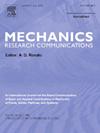基于有限元建模的正四面体点阵结构缺陷激光超声检测
IF 2.3
4区 工程技术
Q3 MECHANICS
引用次数: 0
摘要
点阵结构具有超轻、高强度、高刚度等优点。然而,它们在制造和使用过程中经常出现缺陷。由于其结构的复杂性,检测这些缺陷可能具有挑战性。激光超声技术已成为一种很有前途的检测方法,特别适合于晶格结构。本文建立了一个规则的四面体晶格结构模型,采用有限元方法分析了激光诱导超声波在结构内的传播特性,研究了各种缺陷类型对超声波的影响。首先,建立了激光诱导超声波在晶格结构中的热力学耦合模型,讨论了超声波在不同位置的传播规律;其次,建立了不同类型晶格结构缺陷的模型,分析了缺陷位置和深度对超声波传播的影响;结果表明:超声波在夹层板上部的传播模式为横波、纵波和瑞利波,而在支撑杆表面的传播模式为纵波。当缺陷出现在支撑杆上时,将探头点定位在支撑杆上缺陷的正上方,证明是非常有效的检测方法。当支撑杆与上夹层板交界处出现裂缝时,上夹层板上表面可见明显的反射波。此外,随着裂缝深度的增加,反射波的振幅逐渐增大,呈现非线性趋势。本文章由计算机程序翻译,如有差异,请以英文原文为准。
Laser ultrasonic detection of defects in a regular tetrahedral lattice structure based on finite element modeling
Lattice structures possess advantages such as ultra-lightweight, high strength, and high stiffness. However, they often exhibit defects during manufacture and service. Due to the complexity of their structure, detecting these defects can be challenging. Laser ultrasonic technology has emerged as a promising detection method, particularly suited for lattice structures. In this paper, a regular tetrahedral lattice structure model is established, and the finite element method is employed to analyze the propagation characteristics of laser-induced ultrasonic waves within the structure and investigate the impact of various defect types on these ultrasonic waves. Firstly, the thermodynamic coupling model for laser-induced ultrasonic waves in the lattice structure is established and the propagation rules of ultrasonic waves at different locations is discussed. Secondly, the models for different types of lattice structure defects are created and the effects of defect location and depth on ultrasonic wave propagation are analyzed. The results indicate that the modes of ultrasonic wave propagation in the upper sandwich plate are shear wave, longitudinal wave, and Rayleigh wave, while the ultrasonic wave propagation on the surface of the support rod is characterized as longitudinal wave. When the defect is present on the support rod, positioning the probe points directly above the defect on the support rod proves to be highly effective for detection. Furthermore, when cracks occur at the junction between the support rod and the upper sandwich plate, distinct reflected wave can be observed on the upper surface of the upper sandwich plate. Additionally, as the depth of the crack increases, the amplitude of the reflected wave progressively rises, exhibiting a nonlinear trend.
求助全文
通过发布文献求助,成功后即可免费获取论文全文。
去求助
来源期刊
CiteScore
4.10
自引率
4.20%
发文量
114
审稿时长
9 months
期刊介绍:
Mechanics Research Communications publishes, as rapidly as possible, peer-reviewed manuscripts of high standards but restricted length. It aims to provide:
• a fast means of communication
• an exchange of ideas among workers in mechanics
• an effective method of bringing new results quickly to the public
• an informal vehicle for the discussion
• of ideas that may still be in the formative stages
The field of Mechanics will be understood to encompass the behavior of continua, fluids, solids, particles and their mixtures. Submissions must contain a strong, novel contribution to the field of mechanics, and ideally should be focused on current issues in the field involving theoretical, experimental and/or applied research, preferably within the broad expertise encompassed by the Board of Associate Editors. Deviations from these areas should be discussed in advance with the Editor-in-Chief.

 求助内容:
求助内容: 应助结果提醒方式:
应助结果提醒方式:


